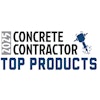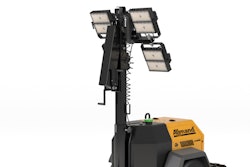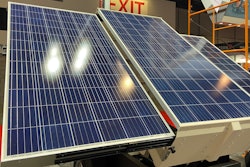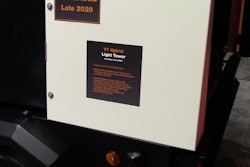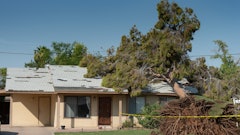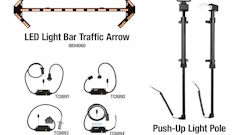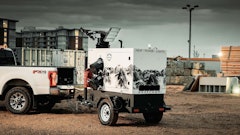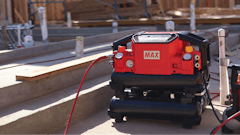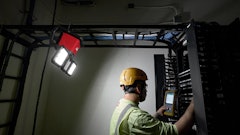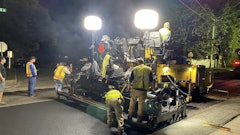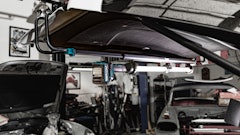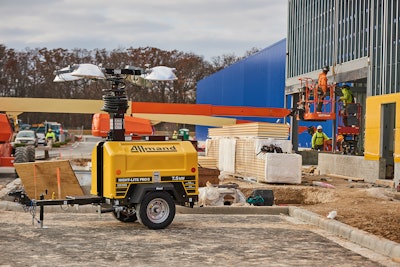
Traditionally, light towers have not set the world on fire in terms of technological advancements, but there are a few important trends to keep in mind today when choosing a unit for your inventory or when making a suggestion to a rental customer. Things like electric models, paralleling capabilities and LED technology are gaining popularity and taking these jobsite workhorses to the next level.
Rental: What are some trends in light tower technology today?
Joan Westwater, product manager, jobsite, Allmand: Lighting technology is constantly advancing in order to provide the customer with more efficient and economical choices, as well as flexibility for the jobsite. Different fuels and power systems utilizing electric, chain, hybrid battery and solar technologies, along with diffused lighting for DOT compliance regulations and construction safety, are all becoming more and more critical to the jobsite.
Eric Massinon, business development director at Chicago Pneumatic Power Technique: Timers and photo eye options are choices that help reduce fuel usage and the labor hours required to tend to multiple light towers. The optics and housing designs improve the amount of light cast from the elements and the optics help control the light directionally from the element, increasing the power and durability.
Angel Nieto, product manager power & light, Atlas Copco Power Technique: The ability to spread the light to optimize light coverage is just as important as efficiently producing light. The design of the optics makes the difference in achieving maximum light coverage. At Atlas Copco, we have reduced the number of LED chips to one or two, depending on the model, and used the right optics to spread the light beam in horizontal and vertical directions.
The floodlight is also important. Our design rapidly radiates the heat produced in the chip, keeping the temperature at the correct level to guarantee performance and durability. The expected average life is 30,000 hours.
Erin Brown, product specialist senior, Doosan Portable Power: LED is still the most prevalent trend. It’s definitely gaining traction as the prices are going down. Total cost of ownership is becoming more important to rental companies, vs the equipment acquisition cost, so more are actually buying LED models because they cost less to own over the long term. At this point, 50 percent of our customers are purchasing LED lamps over traditional metal halide.
Rental: Electric light towers are getting some buzz. What are their primary applications and what are their benefits and drawbacks?
Brown: I still think it’s a niche product and I’ll be interested to see how it takes hold. If you need a a primary power source to provide light, a diesel-powered unit is still your best bet.
Westwater: Electric light towers are becoming more popular especially for the special events industry where indoor applications, engine noise and fuel emissions are a concern. Electric light towers are typically LED lights requiring less power to operate and require an auxiliary power source, or to be plugged into a standard wall outlet. They are small and compact in size, so they can be easily maneuverable by hand, lighter in weight, and simple to operate, providing flexibility for the everyday end user.
Rental: We’re hearing a lot about paralleling. What is it, and how does it work with light towers? What application is it designed for?
Westwater: Paralleling light towers refers to ‘daisy chain’ towers, where multiple towers are chained together, providing several hundred feet of lighting powered by a single source. The chain tower contains no engine or other power source, and best of all — no emissions. It receives its power from the parent generator, light tower, or from an auxiliary power source. One parent generator can power several chain towers, depending on its size and power requirements. This results in flexibility to the jobsite by having a single source provide the necessary power for several chain towers as needed, requiring less overall fuel, less maintenance and less noise. Chain towers can be used in any application where light towers are utilized, but the application will demand tower durability requirements. Chain towers are most popular for special events where minimal refueling and less noise are important factors.
Massinon: Chicago Pneumatic’s range of new electrical light towers (CPLT P2, CPLT V2, CPLT V3 and the CPLT E3) can all be plugged into the power grid or can be used with power from a generator.
Keep in mind you’re limited to the number of these light towers by the size of the circuit they are being used with. The total number used in parallel can’t require more power than the circuit protection is sized for. For example, a 20-amp circuit can supply up to 2,400 watts, enough to power three of the E3 light towers. Or a 30-amp breaker can provide up to 3,600 watts for light. That’s enough power for seven of the V3 LED light towers. The light towers are all rated by the wattage needed. By simply adding the wattage you can calculate the power needed.
With these new light towers, the benefit is that a single generator can provide power for a multitude of light towers. This reduces capital cost, operating cost and service cost — the rental trifecta.
Nieto: LED technology is bringing new possibilities to the light business. In particular, lower consumption and more compact, lighter design expands the possibilities of mobile electric light towers. For example, with Atlas Copco’s electric HiLight light towers, we can now easily couple several light towers and run them from a single power source, daisy chaining them.
For rental jobs where there are noise limitations, indoor projects or where high mobility is important (e.g. urgent deployment required, frequent relocation of the light towers), the new electric light towers, and specifically the ability to have them coupled, adds additional flexibility and versatility for rental companies and their customers.
Electric light towers can also be used in conjunction with self-powered light towers to improve light coverage at the jobsite.
Rental: What is the importance of having different size light towers and how can using paralleling technology meet the needs of more rental customers?
Nieto: Every application requires a different solution in order to optimize performance, efficiency and benefit. Depending on the relevancy of glare, mobility, noise, serviceability, ease of use and — of course — light coverage, Atlas Copco’s range of light towers was designed to meet all these needs.
Massinon: One size fits all is rarely is the best solution. If you need light in a warehouse under construction and you have power from the grid, you wouldn’t want engine-driven light towers. Instead you would want the P2, V2 or V3 electrical light towers — depending on how much light is needed — which have no fuel or engine service required.
Or if you have a location for temporary parking where you do not have power from the grid and the light will be spread out, you would not want the cost of long power cords strung across a parking lot. This is an application for the CPLT V4S, V4W or the V5+S diesel engines. Each application should be looked at individually.
Rental: What are some benefits of LED technology for light towers?
Massinon: LED lights provide brighter, cleaner light – more like day light – and require less power and less maintenance. LED elements last longer and can be turned on and off like the lights in your home. The conventional metal halide (MH) type bulbs require time to come on and they can’t be turned on and off without a cool down period. MH bulbs also require a ballast, which can burn out or fail due to incorrect starting or stopping.
Nieto: The benefits of LED technology are countless... low energy consumption, durable performance, robust design, instant-on light, the list goes on. An important benefit that might often be over looked is that LED has a Color Rendering Index (CRI) above 85 (solar light is 100, metal halide light is around 60). This means that colors can be represented more accurately, closer to solar daylight conditions. This is critical in certain applications.
Rental: Is there still a demand for traditional, incandescent light towers? How should a rental company manage their light tower inventory?
Brown: LED light towers are definitely gaining traction, but metal halide is still the gold standard, it’s what everyone is comfortable with. But we have seen prices for LEDs coming down across the industry so that will make their popularity grow.
Westwater: Metal Halide light towers remain the standard work horse of the industry where light output and even distribution of light are required. Standard diesel/metal halide units should be on hand and readily available for many of the construction applications. For event rentals, LED units are required where exhaust or noise is an issue. Rental companies should carry an inventory that consists of a mix of the different powered models and different light types in order to adequately serve the different industries utilizing light towers.



